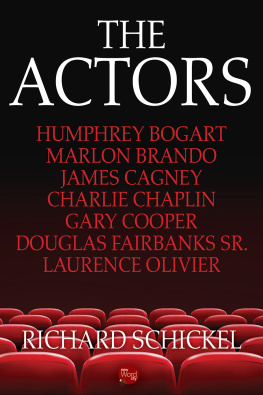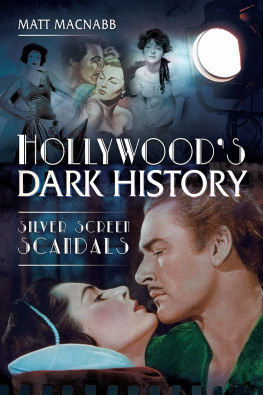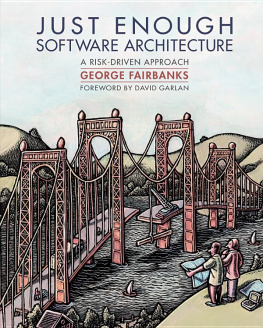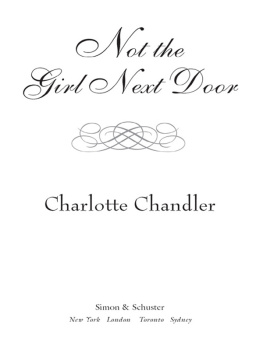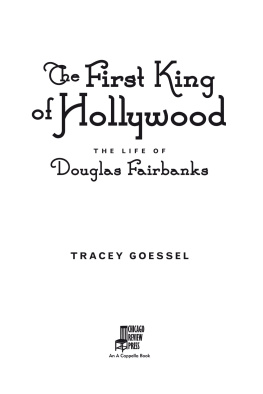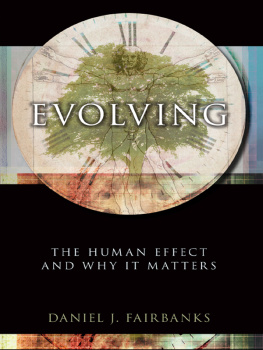A NOTE TO SCHOLARS
Ralph Hancock and Letitia Fairbanks were of the same mind when they began this biography in 1951. They believed that Dougs story could best be conveyed as he told it in his life, augmented by Letitias own memories of her uncle and with explanations and details that were absent from the glossy PR pieces of the day.
As a framework, they drew upon the wealth of publicity generated by the Douglas Fairbanks Pictures Corporation and United Artists. I know this because I found many of these articles when I researched Ralphs collection at his alma mater, the University of Oregon in Eugene.
Included in his literary file was an account of every researchers nightmare. At first, Ralph had set out to write a biography of Fairbanks alone. Then, in 1950, after two years of work, his car was stolen. Ralphs entire set of notes and research were stowed in the trunk, so his work was forever lost. After this devastating blow, he was introduced to Letitia through friends who thought they might tackle the book together. The result was the first full-length biography to be written about Fairbanks after his death in 1939.
The theft of research materials helps explain why, when Fairbanks and Pickford chronicler Booten Herndon asked Ralph about a discrepancy in the 1970s, Ralph told him, If you have a different version, Id advise you to go with it. In the Commentary on Sources at the end of Herndons Mary Pickford and Douglas Fairbanks: The Most Popular Couple the World Has Known (1977), Herndon describes how Letitia responded to his queries. Letitia Fairbanks Smoot, daughter of Robert and the family historian, repeated or corrected and augmented much of The Fourth Musketeer. I suspect that this process was much the same during the 1950s when Letitia worked with Ralph to create this book. Ralph did the writing, and Letitia went over it, correcting and adding pertinent details.
Without Eileen Whitfields early commitment to this project, it is doubtful others would have signed on. I am also deeply indebted to the dedicated staff at the Margaret Herrick Library at the Academy of Motion Picture Arts and Sciences. They are consummate archivists and researchers, dedicated to ensuring that everyone who helped make the movies has a chance to be studied through their inventory. Additionally, Fairbanks researcher extraordinaire Tracey Goessel and Fritzi Kramer of Movies, Silently provided critical details and helped decipher photos and handwritten notes. Finally, film historian, agent, and all-around great guy Michael Troyanborn, like Doug, on May 23rd!helped make my dream of re-publication a reality.
But as always, the story of The Fourth Musketeer begins and ends with the Fairbanks family members who have so generously shared their memories and collectibles, especially Dominick, grandson to Douglas Fairbanks, Jr., and Fairbanks Jr.s widow Vera. This re-publication simply would not have happened without their steadfast commitment and help.
KELLEY SMOOT
San Marcos, Texas
Acknowledgments
EVERYBODY REMEMBERED Douglas Fairbanks and nearly everyone we talked to contributed some valuable bit of information. Without their help this book would not have been possible, and to them all may we write this line of thanks. We are particularly indebted to the following for their help and cooperation: The Library of the Los Angeles County Museum, the Los Angeles Public Library, the San Diego Public Library, the Library of the Academy of Motion Picture Arts and Sciences, Eleanor Cassidy, Donald Crisp, Allan Dwan, Arthur Edeson, Douglas Fairbanks, Jr., Margaret Fealy, Maude Fealy, Art Fenn, Gellmans collection of Fairbanksiana as compiled by George Geltzer, Gerald Geraghty, Sheila Geraghty, Alec Krisel, Chuck Lewis, Raoul Walsh, Mr. and Mrs. Cary Wilson, Lotta Woods, and Bennie Zeidman.
RALPH HANCOCK AND LETITIA FAIRBANKS
Hollywood, California
June 1953
William Cameron Menzies began his production design for The Thief of Bagdad (1924) with this album. The title page (left) and hand-painted leather cover (center) bear Menzies box signature on their left and center-right corners respectively. The last page (right) incorporates A.F. Kales still photo of the Thief and the Princess riding the magic carpet to happiness. Menzies would go on to team up with Victor Fleming, another Fairbanks alumnus, on the 1940 epic Gone with the Wind, for which he received an Oscar. From the collections of the Margaret Herrick Library, Academy of Motion Picture Arts and Sciences
Doug and Mary in the front vestibule of Pickfair with its circular staircase in the background, circa 1927. From the collections of the Margaret Herrick Library, Academy of Motion Picture Arts and Sciences, Gift of Mrs. Vera Fairbanks
A N ARROW IN FULL FLIGHT
It was dark as midnight in the valleys and shallow canyons, and even on the hilltops there was no hint that dawn approached somewhere beyond the coastal range. The last lonesome wail of a late-hunting coyote sounded in the distance, and the shrill buzzing of cicadas in the dry brush beside the trail was not disturbed by the horsemen, for the sounds they made were a part of the cacophony of nature. The sharp ring of iron on stone, the creak of saddle leather, the occasional grunt of a rider, seemed as much a part of the morning as the spider webs or fog drifting across the hills from the sea.
In single file the riders followed Douglas Fairbanks over the winding trail, for only he knew their destination. With some difficulty and by dint of frequent urging of their horses they were able to keep up with him. It was an occupation that left little time for talk, but they were men as unaccustomed to long silences as they were to predawn missions.
Where is he leading us?
To our doom, was the mournful prediction from the man nearest in the shadowy procession.
Then a voice from farther back, Does it have to be so far?
But they knew, each in his own mind, that where Doug went, they would follow. His energy and imagination provided an endless chain of escapades for guests at Pickfair, which for some unaccountable reason men of dignity and prestige were known to join in like a bunch of schoolboys. It was impossible to refuse him anything. Even the most fantastic plot seemed plausible under his driving spirit and guidance.
It was a full hour later and the stars were winking out over the mountains to the east when they finally neared the crest of a hill. Poised on the rim, Douglas turned in his saddle and shouted to them.
Stout hearts, vaqueros! Ride swiftly now! And he plunged from sight into the valley below.
The horsemen looked down at the unexpected scene. Among the large boulders and twisted scrub trees of the canyon, an oasis of light reflected the faces of other men. And at that moment the sound of strumming guitars mellowed the fading night and the voices of a cowboy quartet rose in harmony.
As they rode into the circle of light and dismounted, they smelled steaks cooking on the campfire, and the pungent odor of hot coffee was a mouth-watering fragrance in the morning air.




